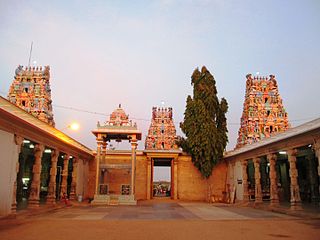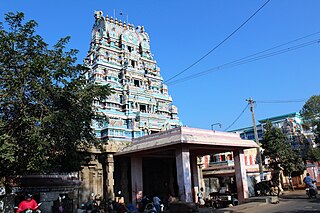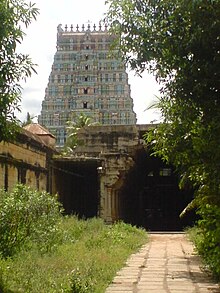
Sivaganga is a city and headquarters of the Sivaganga district in the Indian state of Tamil Nadu. The city is located at a distance of 48 km (30 mi) from Madurai and 449 km (279 mi) from the state capital Chennai.It is an important city in this district for official and commercial purposes. Its nickname was Sivagangai Seemai.

The Marudhu Pandiyars were Diarchal Kings of Sivagangai, Tamil Nadu, India, towards the end of the 18th century. They were known for fighting against the East India Company. They were finally executed by the EIC after being captured by them.

Sivaganga District is one of the 38 districts in Tamil Nadu state, India. This district was formed on 15 March 1985 by trifurcation of Ramanathapuram district into Ramanathapuram, Virudhunagar and Sivagangai districts. Sivaganga is the district headquarters. It is bounded by Pudukkottai district on the Northeast, Tiruchirapalli district on the North, Ramanathapuram district on South East, Virudhunagar district on South West and Madurai District on the West. Karaikudi is the most populous centre in the district. The area's other larger towns include Sivagangai, Kalayar Kovil, Devakottai, Manamadurai, ilayangudi, Thiruppuvanam, singampunari and Tiruppattur. As of 2011, the district had a population of 1,339,101 with a sex ratio of 1,003 females for every 1,000 males.

Arulmigu Meenakshi Amman Temple, also known as Meenakshi Sundareshwarar Temple, is a historic Hindu temple located on the southern bank of the Vaigai River in the temple city of Madurai, Tamil Nadu, India. It is dedicated to the goddess Meenakshi, a form of Parvati, and her consort, Sundareshwarar, a form of Shiva. The temple is at the center of the ancient temple city of Madurai mentioned in the Tamil Sangam literature, with the goddess temple mentioned in 6th-century-CE texts. This temple is one of the Paadal Petra Sthalam. The Paadal Petra sthalam are 275 temples of lord Shiva that are revered in the verses of Tamil Saiva Nayanars of 6th-9th century CE.

Thiruvallur Veeraraghava Swamy Temple is a temple dedicated to the Hindu god Vishnu, located in Thiruvallur, Chennai Metropolitan City, an area and headquarters in Tiruvallur district in the South Indian state of Tamil Nadu. Constructed in Dravidian style of architecture, the temple is glorified in the Divya Prabandha, the early medieval Tamil canon of the Azhwar saints from the 6th–9th centuries CE. It is counted as one among the 108 Divya Desams dedicated to Vishnu. Vishnu is worshipped as Veeraraghava Perumal and his consort Lakshmi as Kanakavalli Thayar.

Thenupuriswarar Temple is a Hindu temple dedicated to the god Shiva located in the holy village of Patteeswaram, Tamil Nadu, India. Shiva is worshiped as Thenupuriswarar, and is represented by the lingam. His consort Parvati is depicted as Nyanambikai (Somakamalambigai). The presiding deity is revered in the 7th century Tamil Saiva canonical work, the Tevaram, written by Tamil saint poets known as the Nayanars and classified as Paadal Petra Sthalam. The temple is associated with the legend of Sambandar to whose view Nandi moved to have a direct view of the presiding deity. Muthupandal festival celebrated in the temple in associated with the legend.
The estate of Sivaganga, as per British records also known as Kingdom of the Lesser Marava, was a permanently settled zamindari estate in the Ramnad sub-division of Madura district, Madras Presidency, British India. Along the estate of Ramnad, it formed one of the two zamindari estates of Ramnad subdivision.

Tiruppukkozhiyur is a Hindu temple dedicated to the deity Shiva, located in Avinasi, a panchayat town in Tiruppur district in the South Indian state of Tamil Nadu. Shiva is worshipped as Avinasiappar, and is represented by the lingam. His consort Parvati is depicted as Karunambigai. The presiding deity is revered in the 7th century Tamil Saiva canonical work, the Tevaram, written by Tamil saint poets known as the Nayanars and classified as Paadal Petra Sthalam.

The Magudeswarar Temple in Kodumudi is a large Hindu temple dedicated to Shiva in Erode district of Tamil Nadu, India. This is the sixth temple in Kongu, the region praised in the Thevaram hymns. it is situated on the banks of the river Kaveri. The sage Agastya is associated with this temple.

Edaganathar Temple is a Hindu temple dedicated to the deity Shiva, located in Thiruvedagam, a village in Madurai district in the South Indian state of Tamil Nadu. The temple is located on the banks of Vaigai River. Shiva is worshipped as Edaganathar, and is represented by the lingam. His consort Parvati is depicted as Visalakshi. The presiding deity is revered in the 7th century Tamil Saiva canonical work, the Tevaram, written by Tamil saint poets known as the nayanars and classified as Paadal Petra Sthalam.

Piranmalai Kodunkundreeswar Temple (பிரான்மலை கொடுங்குன்றீஸ்வரர் கோயில் is a Hindu temple situated at Piranmalai, a hilly village cum temple located in Singampunari Taluk in Sivagangai District, Tamil Nadu State, India. Kodunkundreeswar and Bhairavar temples are located in this village.

Tiruttalinathar temple is a Siva temple located in Thiruputhur near Karaikkudi. This temple is regarded as the 6th of the Tevara Stalams in the Pandya kingdom of Tamil Nadu. The temples Rameswaram and Tiruvadanai are the other Shivastalams nearby. It is one of the shrines of the 275 Paadal Petra Sthalams.
The Thiruppunavayil Shiva temple is located on the seashore in Thiruppunavasal near Pudukkotai in Tamil nadu. This temple is regarded as the 7th of the Tevara Stalams in the Pandya region of Tamil Nadu. The presiding deity is called Vruddhapureeswarar or Pazhampathinathar.

Aiyarappar is a Hindu temple dedicated to Shiva located in the village of Tiruvaiyaru, Tamil Nadu, India. The Five Rivers are Vadavaru, Vennaaru, Vettaaru, Kudamuruttiyaaru and Kaaviriyaaru. Shiva is worshiped as Aiyarappar, and is represented by the lingam and his consort Parvati is depicted as Dharmasamvardhini. The presiding deity is revered in the 7th century Tamil Saiva canonical work, the Tevaram, written by Tamil poet saints known as the nayanars and classified as Paadal Petra Sthalam.

Mallakottai is the name of a panchayat village in the Indian state of Tamil Nadu. It was one of the villages of the ancient "Mallakottai Nadu" once, which was a part of 'Sivagangai Seemai'..
Sivaganga Palace is a palace in Sivaganga district, Tamil Nadu, southern India, about 40 kilometres (25 mi) from Madurai. It is an old royal palace, with many historical connections. The palace was used as residence by queens Velu Nachiyar (1780–90), Vellacci Nachiyar (1790–93) and Rani Kaathama Nachiar (1864–77). No remains of the original Sivaganga Palace exist, but a new palace, known as "Gowri Vilasam", was built by Padamathur Gowry Vallabha Thevar (1801-1829) in the year 19th century. A heritage site of Chettinad, it was the property of Rani Velu Nachiar.

Padalathri Narasimhar Temple or Narasimhar Temple is dedicated to Hindu god Vishnu (Narasimhar) located in Singaperumal Koil, near Chennai City, in the South Indian state of Tamil Nadu. Constructed in the Rock-cut architecture, dedicated to Vishnu, who is worshipped as Narasimhar and his consort Lakshmi as Ahobilavalli, the temple was built by the Pallavas during the 8th century. Earlier in Kanchipuram district, it is now under Chengalpattu district.

Poovanthi is a small town in the Poovanthi panchayat in the Sivaganga district of Tamil Nadu, India. Poovanthi is under the Manamadurai assembly constituency and Sivagangai Lok Sabha constituency. The primary source of income is agriculture.

Muthu Vaduganatha Periyavudaya Thevar was the second king of the Sivagangai Estate which is also known "Lesser Maravar Kingdom". He ruled from 1750 to 1772.



















